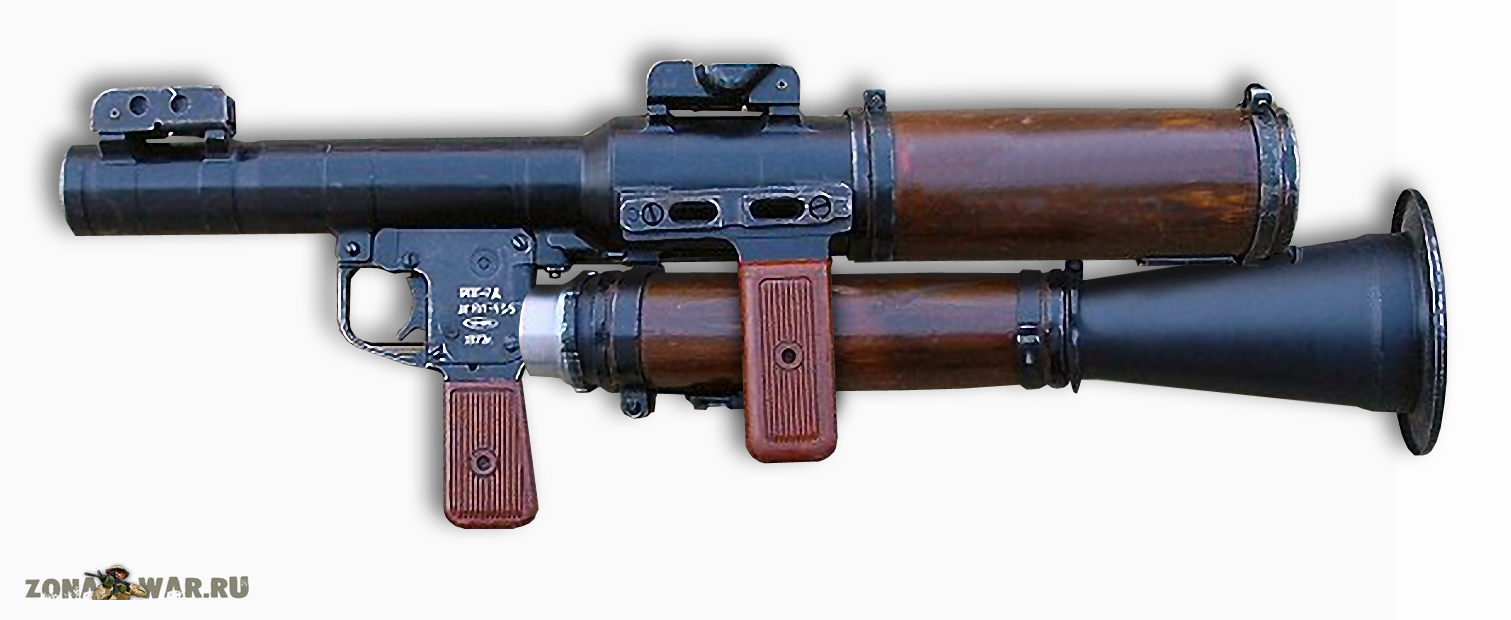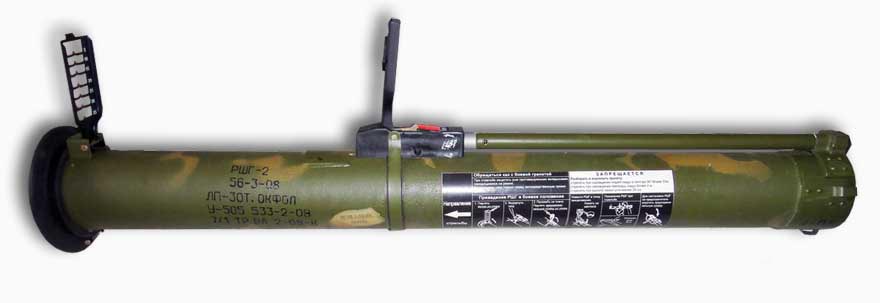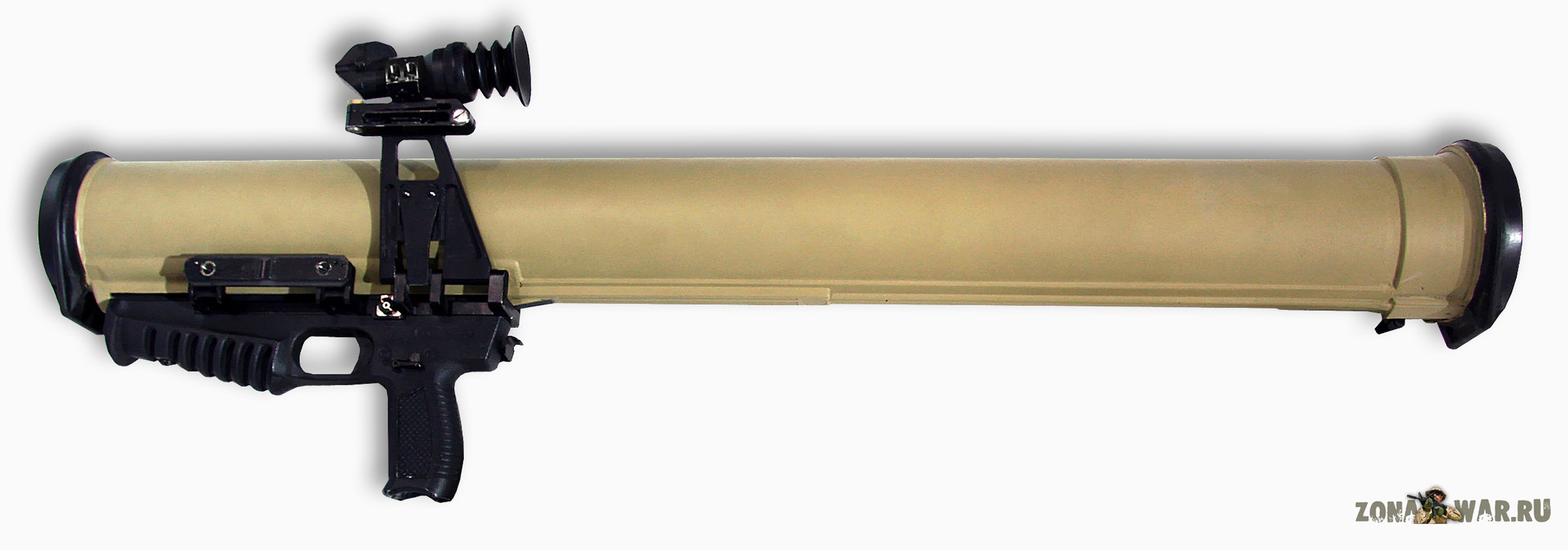 RPG-7V anti-tank rocket launcher
RPG-7V anti-tank rocket launcher
Man-portable anti-lank rocket launchers started to be developed during WWII. A combination of a recoslless launcher and a shaped-charge round resulted in a Sight anti-tank weapon, which became the basis of last-ditch ants-lank defences of an infantry unit
First-generation rocket launchers fired projected grenades (Panzerfaust, RPG-2, Carl Gustav) or rocket-propelled grenades (M18 Bazooka. Ofenrohr SG-82). Both types of rounds featured both advantages and disadvantages. For instance, a projected grenade requires a launcher with small dimensions and weight, but a! the same time its range does not usually exceed 200 m A rocket-propelled grenade has a greater effective range of fire, but a significantly long launcher as well.
Following a number of large-scale researches and tests, the USSR defined specification requirements for developing a new improved man-portable anti-tank rocket launcher lo replace the RPG-2 in the md 1950s The development task envisioned a considerable increase in the accuracy of fire and the effective range, white simultaneously boosting armour penetration and maintaining acceptable weight and dimensions.
The 6SKB-47 design bureau (nowadays the Bazalt State Research and Production Enterprise) for the first time proposed that the rocket-assisted trajectory, the basis of a rocket launcher, be applied to man-portable rockel launchers. The idea belonged to new rocket launcher design project leader Valentin K. Firulin.
The essence of a rocket-assisted projectile design is as follows. An expelling powder charge, burns inside the bore of the launcher and kicks the rocket out of the launcher al a required muzzle velocity. After the rocket flies away from the operator to a. safe range (15-20 m), the rocket motor ignites and significantly increases the velocity, which in its turn increases the range of fire. This design solution allowed the designers to develop a relatively light and reliable rocket launcher. St is worth mentioning that Germany and Sweden„ flagship foreign rocket launcher manufacturers, started using rocket-propelled rounds much later.
In addition to a rocket-propelled round the new rocket launcher featured a number of other innovations. For instance, in order to improve the accuracy of fire it was decided to spin-stabilise the rocket, which started spinning in the bore and continued doing so throughout the trajectory. The spinning was imparted by the expelling powder charge and the rocket motor on a special vane, and during the flight the slow roll was imparted on stabilising fins by ram air. The Point-Initiating Base-Detonating (PIBD) fuse consisted of two separate assemblies: a nose-mounted piezo element, and the initiation train, which is located at the base of the HEAT warhead. A range of fire of up to 500 m required an introduction of optical and later on optronic sights.
The rocket launcher proper was developed by the Kovrov-based OKB-575 design bureau, while its optical sight was developed by the Novosibirsk-based Tochpribor Central Design Bureau. The entire range of rounds for the RPG-7 was mass-produced at the Nizhny Tagil-based PSlanta chemical plant.
The RPG-7 rocket launcher, firing rocket-propelled rounds, is muzzle loaded. When the rocket launcher is fired the gases emerge from the convergent/divergent nozzle at high velocity, and the weapon rests on the firer’s shoulder The rocket launcher consists of the launch tube with the nozzle attached to it, a trigger assembly, and a hammer. The launch tube mounts a pistol grip, iron sights, and a mount for an optical or an optronic sight. A removable handguard is mounted on the launcher to prevent burns. The trigger and the hammer assemblies were completely taken from the RPG-2 rocket launcher. The RPG-7 and its variants feature an extremely simple design and a high reliability.
 RPG-7V anti-tank rocket launcher
RPG-7V anti-tank rocket launcher
The RPG-7 rocket launcher and the PG-7V rocket-propelled projectile entered service with the Soviet Armed Forces in 1961 its airborne version, designated RPG-7D (where D stands for ‘desantny5 or airborne), was developed by V. F. Fundaev from the Tula-based TsKIB SOO (at the present time part of the Instrument Design Bureau). The RPG-7D can be broken down in two halves, which ensures a safe paradrop. This model was fielded in 1963.
Besides Bazalt about a dozen special research and development institutes, design bureaux, and plants took part in developing the RPG-7 rocket launcher. It was joint efforts of experts from various industries that allowed the USSR to develop on such a short notice a weapon that along with the Kalashnikov assault rifle and the T-34 tank became one of the symbols of reliability and efficiency of Soviet-made weapons, and a thing copied and imitated in many foreign countries.
Further refinement of the rocket launcher focused on upgrading existing and developing new rounds of various purposes, as well as introducing insignificant modifications into the sight. These measures have ensured a long life and a high efficiency of the RPG-7V both in the USSR and Russia, and more than 60 foreign states.
 RPG-7D anti-tank rocket launcher
RPG-7D anti-tank rocket launcher
Specifications RPG-7V anti-tank rocket launcher
Ammunition: PG-TV. PG-7VM. PG-7VS. P6-7V81. PG-7VL, PG-TVP, TBG-7V, OG-7V
FffecUve range of fire, m: 500 – (PG-7VM, PG-7VS); 300 – (PG-7VL); 200 – (PG-7VR, TBG-7V); 280 – (OG-7V)
Calibre, mm: 40
Weighs with optical sight, kg: 6,3
Launcher length, mm: 950
Combat rate: 4-6
RPG-7V anti-tank rocket launcher ammunition
| PG-7VM round |  |
| PG-7VS round |  |
| PG-7WL round |  |
| PG-7VR round |  |
| TBG-7V round |  |
| OG-7V round |  |




